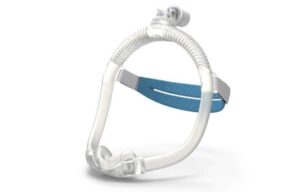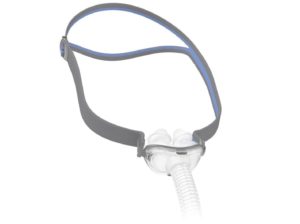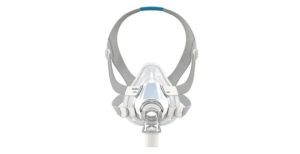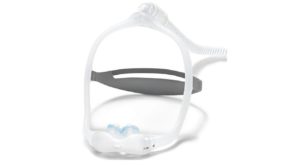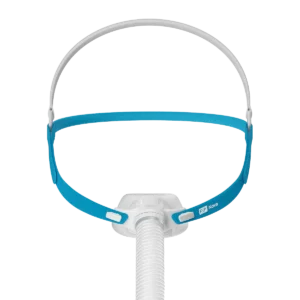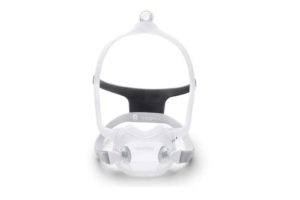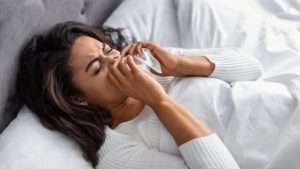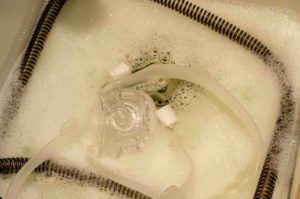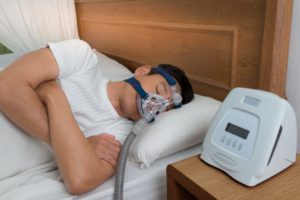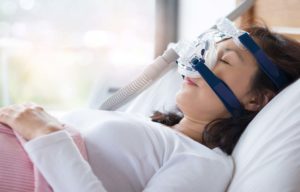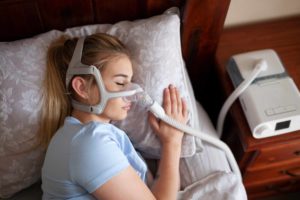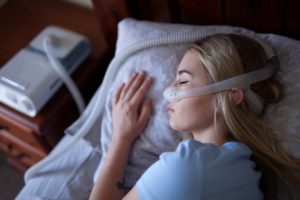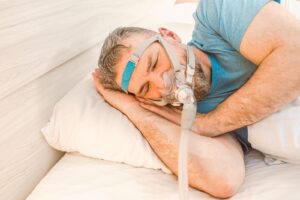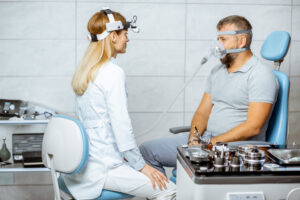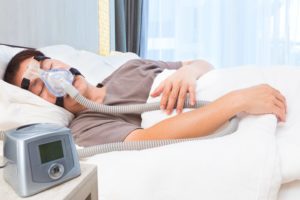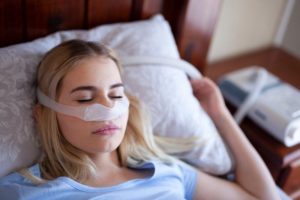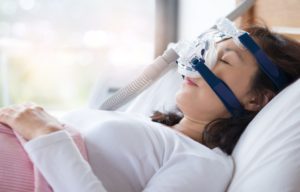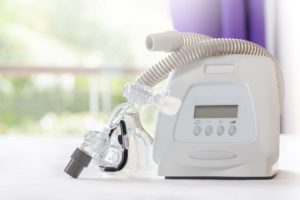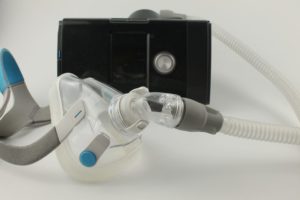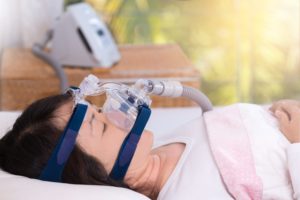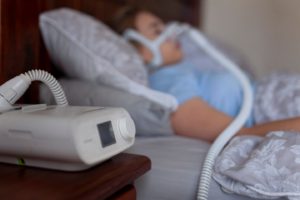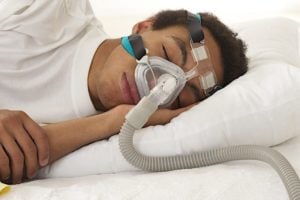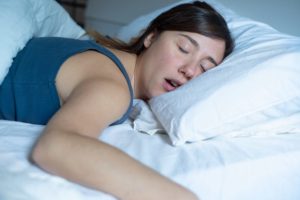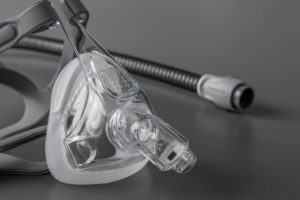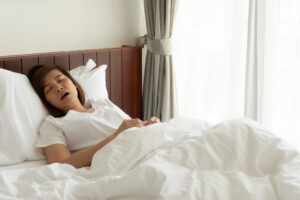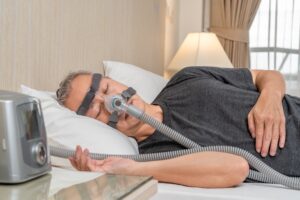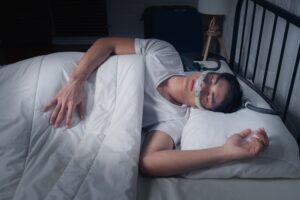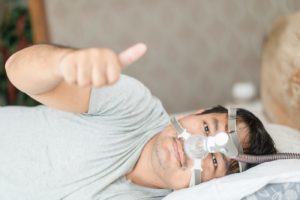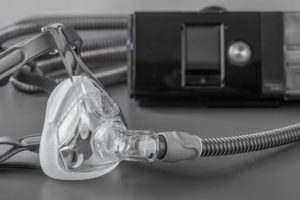When you buy through our links, we may earn a commission. Products or services may be offered by an affiliated entity. Learn more.
CPAP Mask Types
- CPAP masks come in three primary styles, each of which is suited to different breathing styles, sleep positions, and preferences.
- Full face CPAP masks cover both the mouth and nose and require higher pressure settings. They are ideal for mouth breathers and those with chronic congestion.
- Nasal CPAP masks cover only the nose and offer a lighter feel that works well for nose breathers and multiple sleeping positions.
- Nasal pillow CPAP masks have minimal face contact, which makes them popular with active sleepers, people with facial hair, people who wear glasses, and those who are prone to claustrophobia.
CPAP masks are devices designed to attach to a sleeper’s face during CPAP therapy. Though their look and feel can vary depending on the style and brand, they’re typically made from silicone, gel, foam, or another type of flexible material.
Masks fit over or under the nose, mouth, or both. They’re most often clear, and manufacturers generally make them as low-profile as possible to ensure that they stay securely attached during sleep. The best CPAP masks are both comfortable and functional.
There are a few different types of CPAP masks available, and they all have their pros and cons. We’ll explain how each one works and who it’s best for. We’ll also discuss methods for increasing your comfort during CPAP therapy and what to keep in mind when choosing between the different types of CPAP masks.
Parts of a CPAP Mask
Each mask contains multiple components and attachments as part of its design. There are mechanisms to deliver the pressurized air, to attach the mask to the head, to create structure, and to keep the user as comfortable as possible. Each of these individual pieces has its own materials and lifespan to consider.
Most importantly, before purchasing a mask, you should ensure that it’s compatible with the type of CPAP machine you intend to use.
There are several CPAP mask components, and each one has a different function.
| Mask Headgear | Headgear keeps the mask securely attached to the user’s head. Magnetic clips and velcro are popular fasteners that allow for quick and easy detachment. |
| Mask Frame | The frame keeps all the other mask components attached and in place. The headgear and cushion connect to the frame, which is typically made from a pliable material that’s easy to wash. |
| Mask Cushion | Your mask’s cushion is what seals around or beneath your mouth or nose. Cushions are usually made from flexible materials like silicone, gel, or foam. They attach to the mask’s frame and should rest comfortably against your face. |
| Mask Hosing | Pressurized air travels from your CPAP device through your mask’s hosing and to the cushion. This hosing is designed to flex and move with you as you sleep. |
CPAP Mask Types
There are several different types of CPAP masks . The right one for you depends on many factors, including your face shape, sleeping position, pressure settings, and comfort.
Nasal Pillow CPAP Mask
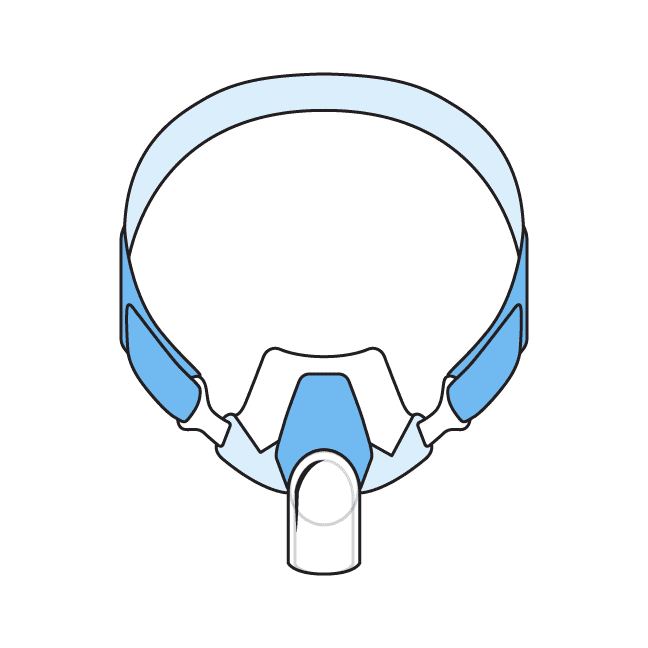
CPAP nasal pillows have a low-profile design that fits between the user’s nose and upper lip. The pillow extends the full width of your nose and seals against your nostrils to provide a leak-proof fit. The hose connects to the pillow, and the entire unit is fairly small and unobtrusive.
Because this style of mask sits beneath the user’s nose, most people find that it’s easy to watch TV or read while wearing their mask. Nasal pillows have the most streamlined design and are often the easiest for users to tolerate.
- Who’s a Match for This Mask Type: Those who breathe through their nose and are looking for a lightweight fit may like nasal pillow CPAP masks. People with facial hair also typically find that nasal pillows seal against their faces more effectively than other mask styles.
- Who’s Not a Good Fit for This Mask Type: Those who have high-pressure settings may want to choose another mask style, as this type may not be able to withstand significant pressure without leaking. Those with deviated septums or chronic congestion may also prefer a different style since they’re more likely to breathe through their mouth.
Nasal CPAP Mask
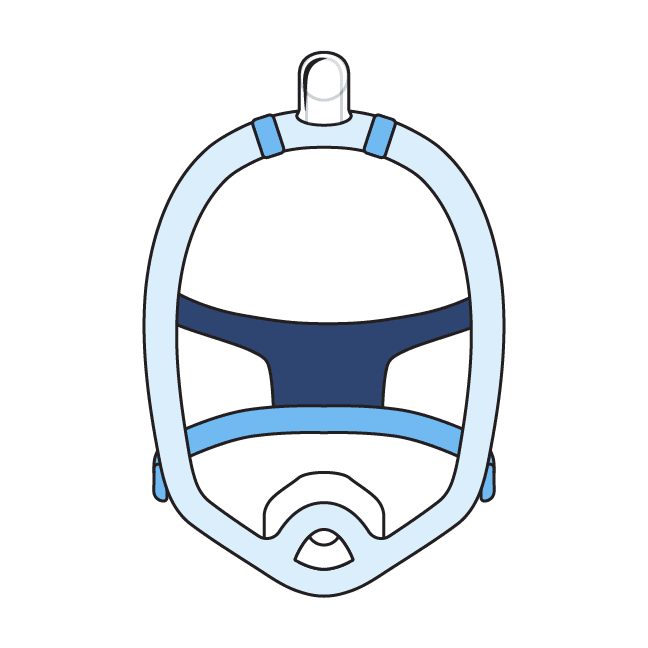
Nasal CPAP masks cover either the entire nose or just the bottom half. This mask sits against the bridge of your nose like a pair of glasses and extends downward to your nostrils. The mask seals around your nose and pushes pressurized air into your nostrils.
This style mask has more volume than a nasal pillow but less than a full-face mask. Depending on where it attaches to the headgear, you may be able to see over top of your nasal mask to read or watch TV.
- Who’s a Match for This Mask Type: Back sleepers will likely find nasal masks an excellent choice. Side sleepers can also successfully use nasal masks, though they should make sure that their pillow won’t cause the mask to shift. Nasal masks are also a suitable option for those who have facial hair or find full-face masks uncomfortable.
- Who’s Not a Good Fit for This Mask Type: This mask may not stay sealed if you sleep on your stomach. It can shift on the pillow and cause leaks, or it could come off entirely. It’s also not a good choice for mouth breathers or people with congestion problems.
Full-Face CPAP Mask
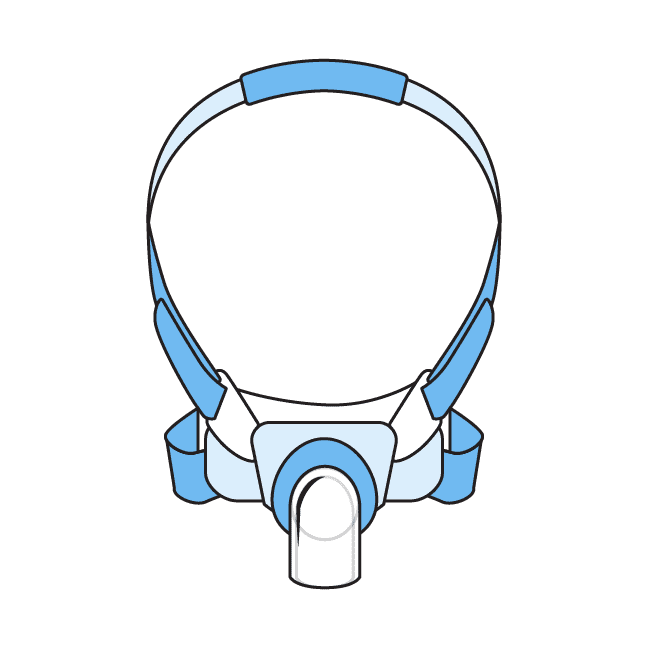
Full-face CPAP masks fit over your nose and mouth and seal against the bottom half of your face. This type of mask takes up the most surface area of all the mask types, and it’s typically within your field of vision. Unlike nasal masks and pillows, full-face masks can deliver air into your mouth, making this style the best option for people who breathe primarily through their mouths.
- Who’s a Match for This Mask Type: People who need high-pressure settings should consider using a full-face mask since it’s better than the other two styles at staying securely attached with increased pressure. Those who breathe through their mouths may also find full-face masks beneficial.
- Who’s Not a Good Fit for This Mask Type: Active sleepers and those who can’t tolerate the size of a full-face mask should steer clear. People with facial hair and full beards may also need to opt for a different style, since full-face masks can’t seal properly against facial hair.
Less Common CPAP Mask Types
Though nasal masks, pillows, and full-face masks are the most popular mask styles, there are also a few other types of masks that CPAP users can choose between.
Nasal Prong CPAP Masks
This type of mask is similar to a nasal pillow, but instead of sealing your nostrils, it uses nasal prongs, or cannulas, to deliver pressurized air . The mask sits underneath your nose, and prongs extend into your nostrils. These seal against your nostrils by inflating and creating air pressure.
This mask style is an excellent option for very active sleepers, as well as people with facial hair. Its very low profile may make it a good fit for those with claustrophobia, and its minimally invasive design may be easier to adhere to for some sleepers.
Oral CPAP Masks
People who breathe through their mouth need a mask that seals over the mouth in order to get effective and consistent air pressure . Oral CPAP masks fit around just the mouth and are an alternative option for people who want a mask with less volume than a full-face mask.
This kind of mask doesn’t require headgear that fits across your forehead, making it a bit more comfortable for some sleepers than full-face masks. People who have allergies or frequent nasal congestion may find an oral CPAP mask the best choice.
Hybrid CPAP Masks
As the name implies, a hybrid CPAP mask uses two methods for delivering air. It seals under your nose as well as over your mouth, transporting air to both breathing passages. People who alternate between nose and mouth breathing may find this type of mask to be the best fit .
Hybrid masks are a bit smaller than traditional full-face masks and may be easier for users to tolerate. However, they’re not suitable for users with facial hair, and they may cause discomfort for people with congestion.
Total Face CPAP Masks
A total face CPAP mask covers your entire face, from above your eyes to below your mouth. This style mask is not necessary for most sleepers, but it can be very effective at preventing leaks for certain people. Even pressure is distributed into the mask, which can be more comfortable for people who are sensitive to high pressure.
This kind of mask has four points of contact with your headgear, and the whole surface area seals against your face. This can help prevent sore spots from developing, since the seal is distributed across more surface area.
How to Choose a CPAP Mask
Introducing a CPAP mask to your routine may make it trickier to sleep in your preferred position . Some masks and sleeping positions aren’t compatible, as your pillow or mattress can interfere with the mask’s fit, cause leaks, or even push the mask off your face entirely.
There are certain mask styles that are better suited to one sleeping position as opposed to another.
Based on Your Sleep Position
| Side Sleepers | Nasal pillows, nasal masks, and prongs are all great picks for side sleepers, due to their lower-profile designs. However, some side sleepers may still find that their mask shifts when it hits their pillow. Using a CPAP-specific pillow can help prevent this from happening. |
| Back Sleepers | Back sleepers have the most options when it comes to picking a mask type. Regardless of which style they choose, it’s unlikely to come into contact with their pillow. Choose headgear that doesn’t fasten at the back to keep your mask as comfortable as possible. |
| Stomach Sleepers | Stomach sleepers can find it tricky to use a CPAP mask. They may develop pressure points where the mask and pillow touch each other, or they may experience leaks because their pillow pushes against their mask. This can also cause neck discomfort. A low-profile nasal pillow is the best option for stomach sleepers, though you should check if your pillow will interfere with your mask’s headgear and tubing. |
| Combination Sleepers | Combination and active sleepers may be happiest using a nasal mask or pillow, as these styles allow for an increased range of motion. They’re also less likely to leak than full-face masks because they don’t touch your pillow. Consider your preferred sleeping positions and choose headgear and a frame accordingly. |
Based on Breathing Style
Different types of masks accommodate different types of breathing. Before choosing a mask, assess whether you breathe through your mouth or nose at night, and consider any factors that may affect your breathing style over time .
- Nasal breathing: If you breathe through your nose during sleep, nasal masks or nasal pillow masks are typically the best options. These masks deliver air through the nose and tend to be lighter and less obtrusive than full-face alternatives.
- Mouth breathing: Some people breathe through their mouth while sleeping because of anatomical factors like a deviated septum, chronic congestion, or habit. In these cases, a full-face mask that covers both the nose and mouth ensures more consistent air pressure delivery.
- Combination: If you alternate between nose and mouth breathing during the night, a full-face mask or hybrid mask design may work best. These options ensure you receive effective therapy regardless of which breathing style you use on a given night. For example, seasonal allergies that cause congestion may temporarily shift you from nasal to mouth breathing.
Based on Pressure Needs
The pressure settings your doctor prescribes may affect which type of mask you choose. Full-face masks that cover both your nose and mouth typically require higher pressure than a mask that covers only your nose. Your healthcare provider can help you understand how your specific prescribed pressure level affects your mask choice.
Based on Facial Features
Your facial features and skin characteristics can also influence which mask works best for you. Nasal pillow masks often work well for those who wear glasses and those with facial hair since they don’t have contact with the bridge of the nose or most of the face. Those with a deviated septum or chronic nasal congestion often breathe through their mouth while sleeping, so a nasal-only mask may be less effective or comfortable. If you have sensitive skin prone to irritation, your healthcare provider can help you identify masks with softer cushioning materials or less contact.
Based on Comfort Preferences
You need to use your CPAP machine consistently in order to get its benefits, so it’s important to find a mask that’s comfortable for you. Some people prefer the secure feeling of full-face masks, but others may find them bulky or uncomfortable and prefer a less invasive nasal design. Larger masks also provoke claustrophobia in some patients. Consider your own preferences, and, if possible, try on a few types of masks before you make a final decision.
Common Problems With CPAP Masks
Consistent nightly use of your CPAP machine is essential for managing sleep apnea and achieving the health benefits of treatment . However, many people experience problems with their CPAP masks that make therapy uncomfortable or difficult to tolerate. Identifying and addressing these issues early on can significantly improve your comfort and adherence to treatment.
Mask Leaks
Air leaks can occur when your mask isn’t properly sealed against your face. You may notice air blowing into your eyes, hear hissing sounds, or see high leak readings on your CPAP machine. Leaks reduce the effectiveness of your therapy and can cause eye irritation or dryness. Common causes include an improper mask fit, worn cushions, or straps that are too tight. To fix leaks, try adjusting the mask position and strap tightness or replacing worn mask components. If leaks persist, you may need a different mask size or style.
Pressure Marks
While temporary red marks that fade within an hour are normal after removing your CPAP mask, lingering indentations or soreness on your face are signs that the mask straps are too tight, or that the mask doesn’t fit properly. Adjust the straps so that they are snug, but not uncomfortable. If marks continue, consider trying a different mask style.
Skin Irritation
Skin irritation, redness, or rashes where the mask contacts your face can develop from pressure, friction, or reactions to mask materials. Keep your mask clean by washing it with mild soap and water, and ensure your face is clean before putting on the mask. Some people benefit from applying a small amount of CPAP-safe moisturizer or using barrier products designed for mask wearers. If you suspect an allergy to the mask materials, ask your supplier about hypoallergenic options or masks with fabric liners.
Mouth Breathing
If you use a nasal or nasal pillow mask but breathe through your mouth during sleep, air can escape through your mouth, which can reduce efficacy and cause discomfort. This is sometimes called “mouth leak.” A chin strap can help keep your mouth closed during sleep. Alternatively, switching to a full-face mask that covers both your nose and mouth can ensure consistent air delivery regardless of your breathing route.
Claustrophobia
Some people feel anxious or claustrophobic when wearing a CPAP mask, especially if it’s a larger full-face design. This feeling can make it difficult to fall asleep or cause you to remove the mask during the night. Smaller mask styles like nasal pillows have minimal facial contact and may feel less confining and bulky. Some CPAP machines offer a “ramp” feature that starts with lower pressure and gradually increases, which can make the experience less overwhelming as you fall asleep.
CPAP Mask Accessories
Wearing a CPAP mask can take some time to get used to, but there are many different accessories on the market designed to make therapy more comfortable.
- Mask Liners: Most CPAP masks and cushions are made from silicone, which can be irritating when placed directly on the skin. Mask liners are fabric barriers made from material that’s designed to feel softer than silicone. They’re often washable and engineered to keep your mask clean and hygienic.
- Chinstraps: CPAP chinstraps are designed for use with a nasal pillow or mask. People who use nasal options must keep their mouth closed in order to get effective CPAP therapy. Chinstraps wrap around or behind the head to keep the mouth closed. They’re made from many different materials that are each designed to feel comfortable against your skin.
- CPAP Pillows: There are different types and shapes of CPAP pillows, but they all have the same goal – to support your head and neck without interfering with your CPAP mask. They accomplish this with unique designs that feature cutouts or curves that accommodate your mask. Side and stomach sleepers may benefit from using a CPAP pillow.
Frequently Asked Questions
What is the most comfortable CPAP mask type?
The most comfortable type of CPAP mask for each person depends on a number of factors including sleep position, breathing style, prescribed air pressure, facial features, and personal preferences. Your healthcare provider can help you choose the most comfortable mask for your needs and preferences.
Which CPAP mask is best for side sleepers?
Side sleepers often prefer masks with minimal facial contact, such as nasal pillows or nasal masks, since these are less likely to shift or leak when pressed against a pillow. However, your breathing style (nose vs mouth) and facial features may play a larger role in determining mask comfort and effectiveness than your sleeping position. Consider all of these factors when choosing a mask, and consult with your healthcare provider to find the best option for your needs.
Do different masks require different pressure settings?
Mask type can affect the pressure settings needed for effective therapy. For example, research shows that full-face masks typically require higher pressure than nasal masks. Your healthcare provider will determine your prescribed pressure based on your individual needs and the severity of your sleep apnea, then help you select a compatible mask.
What type of CPAP mask is best for snoring?
All types of CPAP masks are designed to help treat snoring, but only if you use them consistently. This means that the best type of mask to reduce snoring is the one that feels comfortable and addresses your individual needs, including your breathing style, sleeping position, and facial features.

Still have questions? Ask our community!
Join our Sleep Care Community — a trusted hub of product specialists, sleep health professionals, and people just like you. Whether you’re searching for the perfect mattress or need expert sleep advice, we’ve got you covered. Get personalized guidance from the experts who know sleep best.
References
7 Sources
-
Bachour A, Avellan-Hietanen H, Palotie T, Virkkula P. Practical Aspects of Interface Application in CPAP Treatment. Can Respir J. 2019;2019:7215258. Published 2019 Nov 3. doi:10.1155/2019/7215258
https://pubmed.ncbi.nlm.nih.gov/31781315/ -
Zhu X, Wimms AJ, Benjafield AV. Assessment of the performance of nasal pillows at high CPAP pressures. J Clin Sleep Med. 2013;9(9):873-877. doi:10.5664/jcsm.2984
https://pmc.ncbi.nlm.nih.gov/articles/PMC3746714/ -
Pinto VL, Sankari A, Sharma S. Continuous Positive Airway Pressure. [Updated 2025 Jul 7]. In: StatPearls [Internet]. Treasure Island (FL): StatPearls Publishing; 2025 Jan-.
https://www.ncbi.nlm.nih.gov/books/NBK482178/ -
Andrade RG, Piccin VS, Nascimento JA, Viana FM, Genta PR, Lorenzi-Filho G. Impact of the type of mask on the effectiveness of and adherence to continuous positive airway pressure treatment for obstructive sleep apnea. J Bras Pneumol. 2014;40(6):658-668. doi:10.1590/S1806-37132014000600010
https://pmc.ncbi.nlm.nih.gov/articles/PMC4301251/ -
Ma Z, Hyde P, Drinnan M, Munguia J. Development of a smart-fit system for CPAP interface selection. Proc Inst Mech Eng H. 2021;235(1):44-53. doi:10.1177/0954411920959879
https://pmc.ncbi.nlm.nih.gov/articles/PMC7780270/ -
Landry SA, Mann DL, Beare R, et al. Oronasal vs Nasal Masks: The Impact of Mask Type on CPAP Requirement, Pharyngeal Critical Closing Pressure (Pcrit), and Upper Airway Cross-Sectional Areas in Patients With OSA. Chest. 2023;164(3):747-756. doi:10.1016/j.chest.2023.03.025
https://pubmed.ncbi.nlm.nih.gov/36990149/ -
Weaver TE, Grunstein RR. Adherence to continuous positive airway pressure therapy: the challenge to effective treatment. Proc Am Thorac Soc. 2008;5(2):173-178. doi:10.1513/pats.200708-119MG
https://pubmed.ncbi.nlm.nih.gov/18250209/

